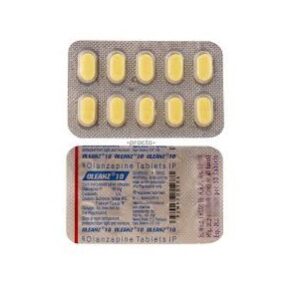Olanzapine
Packages:
| Quantity | Per Pill | Price | Order |
|---|---|---|---|
|
20/10mg pills
Free EMS shipping with every order |
$ 1.95 | $39.00 | |
|
50/10mg pills
Free EMS shipping with every order |
$ 1.80 | $90.00 | |
|
100/10mg pills
Free EMS shipping with every order |
$ 1.20 | $120.00 | |
|
300/10mg pills
Free EMS shipping with every order |
$ 0.80 | $240.00 | |
|
20/20mg pills
Free EMS shipping with every order |
$ 2.45 | $49.00 | |
|
50/20mg pills
Free EMS shipping with every order |
$ 2.10 | $105.00 | |
|
100/20mg pills
Free EMS shipping with every order |
$ 1.45 | $145.00 | |
|
300/20mg pills
Free EMS shipping with every order |
$ 0.87 | $260.00 |
Description:
Olanzapine: Uses, Risks, and Alternatives You Should Know
Olanzapine, sold under the brand name Zyprexa, is one of the most widely prescribed atypical antipsychotics. First approved by the U.S. Food and Drug Administration (FDA) in 1996, it remains a cornerstone in the treatment of serious psychiatric conditions. While effective, it also carries significant side effects, which is why many patients and clinicians weigh alternatives carefully.
This article provides a balanced overview of olanzapine’s uses, risks, and alternatives, drawing on trusted sources such as the National Institutes of Health, NHS, and peer-reviewed research.
What Is Olanzapine Prescribed For?
Olanzapine belongs to the second-generation (atypical) antipsychotics, which are generally preferred over older drugs due to a lower risk of movement disorders. It is commonly prescribed for:
-
Schizophrenia – to reduce hallucinations, delusions, and thought disturbances.
-
Bipolar disorder – effective in acute mania and maintenance therapy.
-
Treatment-resistant depression – often combined with fluoxetine in Symbyax.
Its main mechanism is blocking dopamine (D2) and serotonin (5-HT2) receptors, which helps stabilize mood and reduce psychotic symptoms.
Benefits and Effectiveness of Olanzapine
Clinical trials confirm that olanzapine is highly effective at reducing psychotic symptoms and preventing relapse. According to the American Psychiatric Association, it is often used when other antipsychotics have failed, thanks to its strong efficacy in controlling both positive (hallucinations, delusions) and negative (social withdrawal, apathy) symptoms.
However, its benefits come at a cost—particularly regarding metabolic health.
Side Effects and Risks
One of the biggest concerns with olanzapine is weight gain and metabolic syndrome. Patients frequently report rapid increases in weight, sometimes exceeding 10–15 kg in the first year. This can raise the risk of:
-
Type 2 diabetes
-
High cholesterol
-
Hypertension
Other side effects include drowsiness, constipation, and dry mouth. Less common but serious risks involve tardive dyskinesia (involuntary movements) and neuroleptic malignant syndrome, though these occur less frequently compared to older antipsychotics.
For this reason, most clinicians recommend regular blood tests and lifestyle monitoring when patients are on olanzapine.
Alternatives to Olanzapine
When side effects outweigh benefits, doctors often consider alternatives. These include:
1. Other Atypical Antipsychotics
-
Risperidone (Risperdal) – similar efficacy, but less weight gain for many patients.
-
Aripiprazole (Arpizole) – tends to cause less sedation and metabolic side effects; sometimes considered “weight-neutral.”
-
Quetiapine (Seroquel) – effective for bipolar disorder, but can also cause drowsiness.
2. First-Generation Antipsychotics
-
Haloperidol – still used for acute psychosis but carries a higher risk of movement disorders.
3. Non-Pharmacological Approaches
While medication remains the backbone of schizophrenia and bipolar treatment, psychotherapy (like CBT for psychosis), family therapy, and lifestyle interventions (exercise, diet, mindfulness) significantly improve outcomes when combined with medication.
4. Off-Label and Experimental Options
In some cases, clozapine is used for treatment-resistant schizophrenia, though it requires strict blood monitoring due to risks of agranulocytosis. Researchers are also investigating glutamate modulators and digital therapeutics as adjuncts.
Key Takeaway
Olanzapine is a powerful and effective antipsychotic, often reserved for patients who need strong symptom control. However, its metabolic risks make it less suitable for long-term use in some individuals. Alternatives such as risperidone, aripiprazole, or psychotherapy may provide safer options, depending on the patient’s condition.
The most important step is working closely with a qualified psychiatrist to personalize treatment, monitor side effects, and adjust the care plan as needed.
Disclaimer: This article is for educational purposes only. It should not replace professional medical advice. Always consult a licensed healthcare provider before making changes to your medication.
